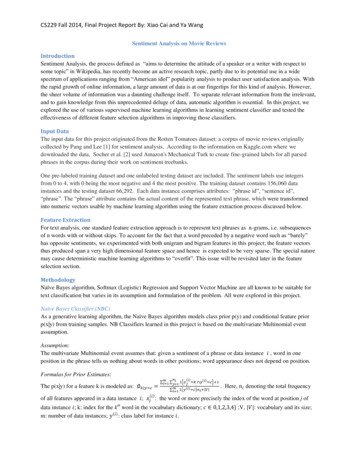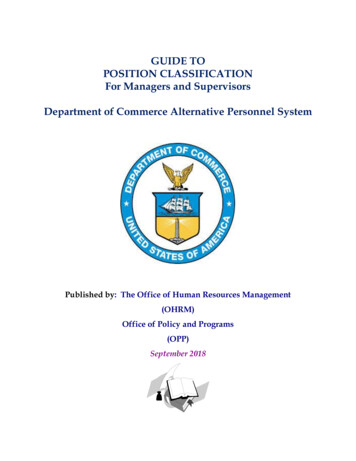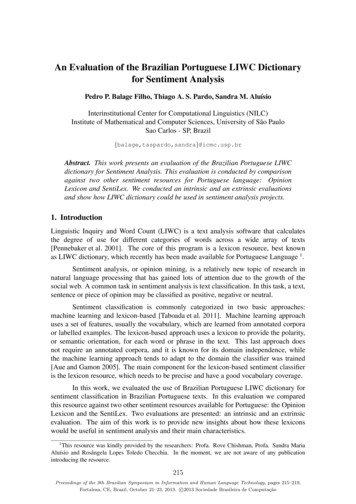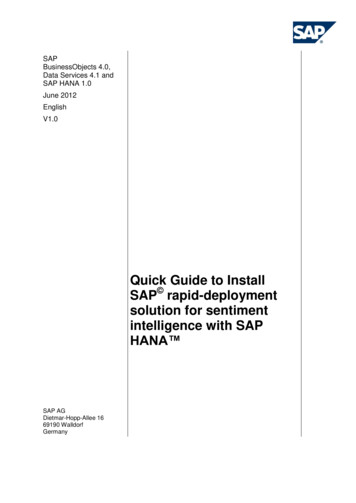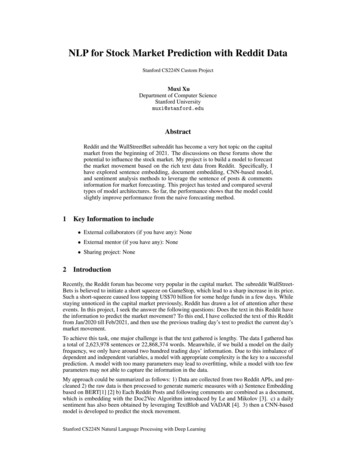
Transcription
DEGREE PROJECT IN TECHNOLOGY,FIRST CYCLE, 15 CREDITSSTOCKHOLM, SWEDEN 2018Sentiment classification onAmazon reviews using machinelearning approachesSEPIDEH PAKNEJADKTH ROYAL INSTITUTE OF TECHNOLOGYSCHOOL OF ELECTRICAL ENGINEERING AND COMPUTER SCIENCE
KTH Computer Scienceand CommunicationSentiment klassificering på Amazon recensionermed hjälp av maskininlärningsteknikerSepideh PaknejadDegree Project in Computer Science, DD142XSupervisor: Richard GlasseyExaminer: Örjan EkebergCSC, KTH June 2018
AbstractAs online marketplaces have been popular during the past decades, theonline sellers and merchants ask their purchasers to share their opinionsabout the products they have bought. As a result, millions of reviews arebeing generated daily which makes it difficult for a potential consumerto make a good decision on whether to buy the product. Analyzing thisenormous amount of opinions is also hard and time consuming for productmanufacturers. This thesis considers the problem of classifying reviewsby their overall semantic (positive or negative). To conduct the studytwo di erent supervised machine learning techniques, SVM and Naı̈veBayes, has been attempted on beauty products from Amazon. Theiraccuracies have then been compared. The results showed that the SVMapproach outperforms the Naı̈ve Bayes approach when the data set isbigger. However, both algorithms reached promising accuracies of at least80%.1
SammanfattningEftersom marknadsplatser online har varit populära under de senastedecennierna, så har online-säljare och inköpsmän ställt kunderna frågorom deras åsikter gällande varorna de har köpt. Som ett resultat genererasmiljontals recensioner dagligen vilket gör det svårt för en potentiell konsument att fatta ett bra beslut om de ska köpa produkten eller inte. Attanalysera den enorma mängden åsikter är också svårt och tidskrävandeför produktproducenter. Denna avhandling tar upp problemet med attklassificera recensioner med deras övergripande semantiska (positiva eller negativa). För att genomföra studien har två olika övervakade maskininlärningstekniker, SVM och Naı̈ve Bayes, testats på recensioner avskönhetsprodukter från Amazon. Deras noggrannhet har sedan jämförts.Resultaten visade att SVM-tillvägagångssättet överträ ar Naı̈ve Bayestillvägagångssättet när datasetet är större. Båda algoritmerna nådde emellertid lovande noggrannheter på minst 80%.2
Contents1 Introduction1.1 Problem Statement . . . . . . . . . . . . . . . . . . . . . . . . . .1.2 Outline of the report . . . . . . . . . . . . . . . . . . . . . . . . .4452 Background2.1 Sentiment classification and analysis . . . . . . . . . . .2.2 Sentiment classification using Machine learning methods2.2.1 SVM . . . . . . . . . . . . . . . . . . . . . . . . .2.2.2 Naı̈ve Bayes . . . . . . . . . . . . . . . . . . . . .2.2.3 Feature extraction . . . . . . . . . . . . . . . . .2.3 Sentiment classification using Lexicon based methods . .2.4 Related work . . . . . . . . . . . . . . . . . . . . . . . .6668889103 Method3.1 Programming environments3.2 The data set . . . . . . . .3.2.1 Data preparation . .3.3 Machine learning classifiers.1212121313.4 Result154.1 First experiment . . . . . . . . . . . . . . . . . . . . . . . . . . . 154.2 Second experiment . . . . . . . . . . . . . . . . . . . . . . . . . . 155 Discussion175.1 Limitations and further study . . . . . . . . . . . . . . . . . . . . 176 Conclusion19References203
1IntroductionAs online marketplaces have been popular during the past decades, the onlinesellers and merchants ask their purchasers to share their opinions about theproducts they have bought. Everyday millions of reviews are generated all overthe Internet about di erent products, services and places. This has made theInternet the most important source of getting ideas and opinions about a product or a service.However, as the number of reviews available for a product grows, it is becomingmore difficult for a potential consumer to make a good decision on whether tobuy the product. Di erent opinions about the same product on one hand andambiguous reviews on the other hand makes customers more confused to getthe right decision. Here the need for analyzing this contents seems crucial forall e-commerce businesses.Sentiment analysis and classification is a computational study which attempts toaddress this problem by extracting subjective information from the given textsin natural language, such as opinions and sentiments. Di erent approacheshave used to tackle this problem from natural language processing, text analysis, computational linguistics, and biometrics. In recent years, Machine learningmethods have got popular in the semantic and review analysis for their simplicity and accuracy.Amazon is one of the e-commerce giants that people are using every day foronline purchases where they can read thousands of reviews dropped by othercustomers about their desired products. These reviews provide valuable opinions about a product such as its property, quality and recommendations whichhelps the purchasers to understand almost every detail of a product. This isnot only beneficial for consumers but also helps sellers who are manufacturingtheir own products to understand the consumers and their needs better.This project is considering the sentiment classification problem for online reviews using supervised approaches to determine the overall semantic of customerreviews by classifying them into positive and negative sentiment. The data usedin this study is a set of beauty product reviews from Amazon that is collectedfrom Snap dataset (Leskovec & Sosic, 2016).1.1Problem StatementSentiment classification aims to determine the overall intention of a written textwhich can be of admiration or criticism type. This can be achieved by usingmachine learning algorithms such as Naı̈ve Bayes and Support Vector Machine.So, the problem that is going to be investigated in the project is as follow:Which machine learning approach performs better in terms of accuracyon the Amazon beauty products reviews?4
1.2Outline of the reportThe rest of the thesis is structured as follow:Section 2, the Background, consists of essential definitions and theory to understand the other sections of this thesis. It also introduces related work done inthis area of research. This is followed by the Methods, in section 3, where theprocedure of the study has been described. The results from the experimentsare gathered in section 4 and discussed in section 5. Finally, section 6 concludesthe study.5
22.1BackgroundSentiment classification and analysisElectronic commerce is becoming increasingly popular due to the fact thate-commerce websites allow purchasers to leave reviews on di erent products.Millions of reviews are being generated everyday by costumers which makes itdifficult for product manufacturers to keep track of customer opinions of theirproducts. Thus, it is important to classify such large and complex data in orderto derive useful information from a large set of data. Classification methods arethe way to tackle such problems. Classification is the process of categorizingdata into groups or classes based on common traits (Pandey et al. 2016; Rain2013). A common concern for organizations is the ability to automate the classification process when big datasets are being used (Liu et. al 2014).Sentiment analysis, also known as opinion mining, is a natural languageprocessing (NLP) problem which means identifying and extracting subjectiveinformation of text sources. The purpose of sentiment classification is to analyzethe written reviews of users and classify them into positive or negative opinions,so the system does not need to completely understand the semantics of eachphrase or document (Liu 2015; Pang et. al 2002; Turney & Littman 2003).This however is not done by just labeling words as positive or negative. Thereare some challenges involved. Classifying words and phrases with prior positiveor negative polarity will not always work. For example, the word “amazing”has a prior positive polarity, but if it comes with a negation word like “not”,the context can completely change (Singla et. al 2013).As Ye et. al (2009) state the word ”unpredictable” camera has a negative meaning to that camera while ”unpredictable” experience is considered as positivefor tourists.Sentiment classification has been attempted in di erent fields such as moviereviews, travel destination reviews and product reviews (Liu et al. 2007; Pang etal. 2009; Ye et al. 2009). Lexicon based methods and machine learning methodsare two main approaches that are usually used for sentiment classification.2.2Sentiment classification using Machine learning methodsThere is a large number of papers that have been published in the field of machine learning. One of the most used approaches for sentiment classification ismachine learning algorithms. This section attempts to cover some of them.One of the first definitions of machine learning that has been provided by TomMitchell (1997) in his book Machine Learning is as follow:”A computer program is said to learn from experience E with respect to someclass of tasks T and performance measure P if its performance at tasks in T, asmeasured by P, improves with experience E.”6
Machine learning aims to develop an algorithm in order to optimize the performance of the system by using example data. The solution that machinelearning provides for sentiment analysis involves two main steps. The first stepis to ”learn” the model from the training data and the second step is to classifythe unseen data with the help of the trained model (Khairnar & Kinikar 2013).Machine learning algorithms can be classified in di erent categories:a. supervised learningb. semi-supervised learningc. unsupervised learninga. In Supervised Learning the process where the algorithm is learning fromthe training data can be seen as a teacher supervising the learning process of itsstudents (Brownlee 2016). The supervisor is somehow teaching the algorithmwhat conclusions it should come up with as an output. So, both input and thedesired output data are provided. It is also required that the training data isalready labeled. If the classifier gets more labeled data, the output will be moreprecise. The goal of this approach is that the algorithm can correctly predictthe output for new input data. If the output were widely di erent from theexpected result, the supervisor can guide the algorithm back to the right path.There are however some challenges involved when working with supervised.The supervised learning works fine as long as the labelled data is provided.This means that if the machine faces unseen data, it will either give wrong classlabel after classification or remove it because it has not ”learnt” how to label it(Cunningham et al. 2008).b. Unsupervised learning in di erence with supervised learning is trained onunlabeled data with no corresponding output. The algorithm should find outthe underlying structure of the data set on its own. This means that it has todiscover similar patterns in the data to determine the output without havingthe right answers. One of the most important methods in unsupervised learningproblems is clustering. Clustering is simply the method of identifying similargroups of data in the data set (Kaushik 2016).For sentiment classification in an unsupervised manner it is usually the sentiment words and phrases that are used. This means that the classification of areview is predicted based on the average semantic orientation of the phrases inthat review (Turney 2002). This is obvious since the dominating factor for sentiment classification is often the sentiment words (Berk 2016). This techniquehas been used in Turney’s study (2002).c. Finally, Semi-supervised learning which has the benefit of both supervised and unsupervised learning, refers to problems in which a smaller amountof data is labelled, and the rest of the training data set is unlabeled. This is useful for when collecting data can be cheap but labelling it can be time consumingand expensive. This approach is highly favorable both in theory and practicebecause of the fact that having lots of unlabeled data during the training process tends to improve the accuracy of the final model while building it requiresmuch less time and cost (Zhu 2005). In Dasgupta and Vincent Ng. (2009) asemi-supervised learning was experimented where they used 2000 documents as7
unlabeled data and 50 randomly labeled documents.2.2.1SVMSupport vector machines (SVM) are supervised learning method that canbe used for solving sentiment classification problems (Cristianini & ShaweTaylor 2000). This technique is based on a decision plane where labeled trainingdata is placed and then algorithm gives an optimal hyperplane which splits thedata into di erent groups or classes. As seen in figure 1. the best hyperplane isthe one that separates the classes with the largest margin. This is achieved bychoosing a hyperplane so that its distance from the nearest data on each classis maximized (Berk 2016).Figure 1: ”H1 does not separate the classes. H2does, but only with a smallmargin. H3separates them with the maximum margin.” (Zack Weinberg 2012)2.2.2Naı̈ve BayesNaı̈ve Bayes is another machine learning technique that is known for beingpowerful despite its simplicity. This classifier is based on Bayes theorem andrelies on the assumption that the features (which are usually words in text classification) are mutually independent. In spite of the fact that this assumptionis not true (because in some cases the order of the words is important), Naı̈veBayes classifiers have proved to perform surprisingly well (Rish 2001). The firststep that should be carried out before applying the Naı̈ve Bayes model on textclassification problems is feature extraction.2.2.3Feature extractionSince machine learning algorithms work only with fixed-length vector of numbersrather than raw text, the input (in this case text data) need to be parsed. Themethod for transforming the texts into features is called the Bag of words model8
of text, which is a commonly used method of feature extraction. The approachworks by creating di erent bags of words that occur in the training data setwhere each word is associated with a unique number. This number shows theoccurrence of each word in the document. A simple illustration of the Bag ofwords model can be seen in figure 2. The model is called a bag of words becausethe position of the words is in the document discarded (Raschka 2014).Figure 2: A simple illustration of the Bag of words model. Figure: (PrabhatKumar Sahu, 2017)2.3Sentiment classification using Lexicon based methodsLexicon based method is another unsupervised approach, which relies on wordand phrase annotation. To compute a sentiment score for each text, this methoduses a dictionary of sentiment words and phrases (Taboada et al. 2011). Inlexicon-based methods the simplest approach for determining the sentiment ofa review document where is to use a count-based approach. If we have a textand a lexical resource containing the positive and negative annotation of wordsand phrases, we can assign the polarity of the review. This means that if thenumber of positive words is more than the negative ones the polarity of thereview is positive. If there are more negative sentiment words than positivesentiment words, the overall sentiment of the text is then negative (Mukherjee2017).However, using only sentiment words and phrases for sentiment classificationis not enough. Sentiment lexicon for sentiment analysis is necessary but it isnot sufficient. There are some issues involved with this method that Liu (2012)argues about:1. positive or negative sentiment words may have di erent interpretation indi erent domains. For instance, the word ”suck” usually have a negative sentiment, but it can also indicate a positive sentiment. For example, ”This camerasucks,” expresses a negative opinion but ”This vacuum cleaner really sucks.” isa positive opinion.9
2. Sarcastic sentences are usually hard to deal with even if they contain sentiment words. For example, ”What a great car! It stopped working in two days.”This is a negative opinion even though it contains the word ”good” which is apositive word.3. it can happen that a phrase or opinion does not have a sentiment word, so itmakes it hard for the machine to determine the compute a sentiment score forthe opinion. ”This washer uses a lot of water” has no sentiment words but itimplies a negative opinion about the washer.Hu and Liu, (2004), work is one of the first studies on this method. They proposed a lexicon-based algorithm for sentiment classification. Since they believedthat a review usually contains some sentences with negative opinions and somesentences with positive opinions, they performed classification at the sentencelevel. For each sentence they identify if it is expressing a positive or negativeopinion and then a final summary of the review is produced.2.4Related workDue to the proliferation of online reviews, Sentiment analysis has gained muchattention in recent years. Therefore, many studies have been devoted to thisresearch area. In this section, some of the most related research works to thisthesis are presented.Joachims (1998) experimented SVM for text classification and showed that SVMperformed well in all experiments with lower error levels than other classification methods.Pang, Lee and Vaithyanathan (2002) tried supervised learning for classifyingmovie reviews into two classes, positive and negative with the help of SVM andNaı̈ve Bayes and maximum entropy classification. In terms of accuracy all threetechniques showed quite good results. In this study they tried various featuresand it turned out that the machine learning algorithms performed better whenbag of words was used as features in those classifiers.In a recent survey that was conducted by Ye et al. (2009), three supervisedmachine learning algorithms, Naı̈ve Bayes, SVM and N-gram model have beenattempted on online reviews about di erent travel destinations in the world. Inthis study, they found that in terms of accuracy, well trained machine learningalgorithms performs very well for classification of travel destinations reviews.In addition, they have demonstrated that the SVM and N-gram model achievedbetter results than the Naı̈ve Bayes method. However, the di erence among thealgorithms reduced significantly by increasing the number of training data set.Chaovalit and Zhou (2005) compared the supervised machine learning algorithmwith Semantic orientation which is an unsupervised approach to movie reviewand found that the supervised approach provided was more reliable than theunsupervised method.10
According to many research works, Naı̈ve Bayes, SVM are two most used approaches in sentiment classification problems (Joachims 1998; Pang et al. 2002;Ye et al. 2009). This thesis, therefore tries to apply supervised machine learningalgorithms of Naı̈ve Bayes and SVM to the beauty product reviews of Amazonwebsite.11
3MethodThis section presents the method of the study. The programming environmentswill be described in the first part. How and where the data was gathered aswell as the data preparation approach will be discussed in the second part. Inthe last part, the procedure of machine learning classifiers will be explained.3.1Programming environmentsPython is one of the most widely used programming language in machine learning and data science. Python has a huge set of libraries that can be used forsolving various machine learning algorithms. The programming language usedin this study is Python because of its wealth of libraries and ease of use. Scikitlearn is one of many libraries in Python that features a variety of supervisedmachine learning algorithms (Pedregosa et al. 2011). It provides di erent classification techniques such as SVM, Naı̈ve Bayes. It also o ers techniques forfeature extraction.3.2The data setThe first step for conducting the research includes data collection for trainingand testing the classifiers. The data is collected from SNAP data set becauseAmazon does not have an API like Twitter to download reviews with. Theformat of the downloaded file was one-review-per-line in JSON. The file wasconverted to the Comma Separated Values (CSV) format, as it is more convenient for python to handle this type of files. The data set consists of 252000reviews of di erent beauty products. Each review includes nine features as eDescriptionId of the userproductIdname of the userfraction of users who found the review helpfultext of the reviewrating of the productreview summarytime of the review in unix timedate of the reviewTable 1: Describes features of each product12
The following is an example review in Json file:{”reviewerID”: ”A4DIVP0NEQDA3”,”asin”: ”B000052WYD”,”reviewerName”: ”Amazon Customer”,”helpful”: [1, 1],”reviewText”: ”This product met my needs for Upper Lip shadow. I found it tobe non oily, easy to smooth over skin and light on skin. You will need to usea press power for your skin tone after applying the concealer. Very please withthe results.”,”overall”: 5.0,”summary”: ”Magic Stick for Upper Lip Shadow”,”unixReviewTime”: 1386806400,”reviewTime”: ”12 12, 2013”}3.2.1Data preparationFor preparing the desired data a simple code was written in python to removethe useless features. Many features were removed except the summary of thereview, the text of the review itself, score and productId. The score that isgenerated by the reviewer includes a number of stars on scales of 1 to 5. Reviews that were rated with one or two stars were considered as negative andthose with four or five stars were considered as positive. Reviews with threestars usually contain many mixed reviews and are difficult to be labeled into apositive or negative category.In this study, two experiments have been conducted. In the first experimentthe whole data set was used. Since the number of reviews were quite enoughto get a reasonable result from the classifiers the reviews with three stars wereomitted to avoid any complication while training the algorithms.However, in the second experiment due to the small number of data thereviews with three stars were also considered as negative.The same code was then used to label the data. The reviews that were considered as positive got a score of ”1” and the remaining ones got a ”0” score.3.3Machine learning classifiersTo carry out the experiments, each classifier algorithm needs to be trained before being tested. In order to train and use the classifiers, the data was dividedinto two data sets as training and testing data sets. As mentioned earlier, twoexperiments have been conducted in this research. In each experiment, the classifiers were trained and tested once on the reviews itself and once on the reviewsummaries.For the first experiment a corpus of 150000 data were collected as trainingdata set and the remaining 48500 for testing the accuracy of the classifiers. Thenext step was to transform the review texts into numerical features before being13
fed to the algorithms. This was done by using the Bag of words model. Thethird step was to train the Naı̈ve Bayes and SVM classifiers. The last step wasto apply the trained classifiers on the test data to measure their performance bycomparing the predicted labels with the actual labels that have not been givento the algorithms. Figure 3 shows an illustration of the wholr procedure.Figure 3: A basic illustration of the sentiment classification by supervised machine learning algorithms. Figure: (Choi & Lee, 2017)For the second experiment a smaller number of data were chosen. Thereviews were grouped by the productId and the first 10 products with mostreviews, as shown in table 2, were chosen to apply the algorithms on them. 300data were then collected from each product as training data set. The rest of theprocedure was the same as the first experiment.Nr of e 2: First 10 products with most reviews14
4ResultThis section presents the results of the study. The accuracy value shows thepercentage of testing data set which were classified correctly by the model. Theaccuracy of two di erent machine learning algorithms on 2 sets of experimentsare shown in tables 3, 4 and 5.4.1First experimentThe results from the first experiment are shown in Table 3 , where it shows theaccuracy of Naı̈ve Bayes and SVM on the whole data set both on the reviewsand the summaries.On reviewsOn summariesNaı̈ve Bayes90.16%92.72%SVM93.02%93.20%Table 3: The accuracy of the machine learning methods on the whole data setBoth algorithms have achieved accuracies over 90% for both cases, althoughSVM got better results. The Naı̈ve Bayes approach has got better result whenapplied on the summaries.4.2Second experimentTable 4 and Table 5 show the results from the second experiment where theclassifiers were trained and tested on the first 10 products with the most reviews and similar to the first experiment once on the reviews and once on DIB007BLN17KB000142FVWNaı̈ve .09%86.55%87.96%83.02%89.25%Table 4: The accuracy of the machine learning methods on 10 products usingthe reviews itself15
000142FVWNaı̈ve .43%85.03%87.32%81.54%85.53%Table 5: The accuracy of the machine learning methods on 10 products usingthe summariesIn the second set of experiments, where the number of reviews is much smallerthan the first experiment, the Naı̈ve Bayes method achieved better accuracythan the SVM in both cases. However, the accuracy is still quite good rangingfrom 80% to 90%.16
5DiscussionThe main goal of this study was to determine which machine learning algorithmof SVM and Naı̈ve Bayes methods performs better in the task of text classification. This was accomplished by using the Amazon beauty products as data set.The classifiers were evaluated by comparing their accuracies in di erent casesof experiments.The overall accuracies of two machine learning algorithms in di erent experiments are shown in tables 3, 4 and 5. The results from the first set of experimentsshown in table 3 indicated that the SVM approach got better accuracy than theNaı̈ve Bayes in both cases where the algorithms applied on the reviews andwhen they have been applied on the summaries. The di erence in accuraciesbetween these approaches is however very small.From this experiment it can be found out that well trained machine learningalgorithms with enough data as training data set can perform very good classification. In terms of accuracies, SVM tends to do better than Naive Bayes,although the di erences aren’t very large, and the algorithms can reach morethan 90% of classification correctly.The results from the second set of experiments shown in Table 4 and 5 indicatedthat the Naı̈ve Bayes approach had better accuracy than the SVM in both cases.In this experiment the data set was much smaller than the previous experiment,300 reviews from 10 di erent products.A possible explanation for this di erence can be the size of the data sets. In thefirst experiment the size of the training data set is much bigger than the secondexperiment. This can lead to an assumption that the SVM model works betterwith more data. Fang and Zhan (2015) had a similar result in their experiment.In their paper they tackle the problem of sentiment analysis on Amazon reviewsby using the Naı̈ve Bayes, SVM and Random Forest model. They demonstratedthat when the models get more training data the SVM model outperforms theother classifiers.Another reason can be the reviews with 3 stars which usually are categorizedas neutral. However, In the second experiment due to the small size of dataset they were considered as negative. This could have a ected the result of thesecond experiment. In future study it would be interesting to categorize themas positive to see whether it gives a di erent result.5.1Limitations and further studyFor conducting the experiments in this thesis, no pre-processing has been doneon the data set. Pre-processing is the process where the data is being cleanedand prepared before being fed to the algorithms. Online reviews usually containmany irrelevant and uninformative features which may not even have an impacton the orientation of them. This process involves removing many steps such as17
white space removal and stop words removal etc.The results from all experiments implies that both approaches give higher accuracies when they are being applied on the summaries of the reviews. Thepossible explanation for this result might be the nature of the reviews. Thereviews itself contain a large amount of words, which can lead to sparsity inbag of words features. As a result we see that the accuracies of the algorithmsfor all experiments are higher when applied on the summaries which are moreinformative and contain limited number of words.In this study the text reviews were not pre-processed before being fed to theclassifiers. However, Haddi et al. (2013) show in their study that pre-processingthe data can significantly enhance the classifier’s performance. Their experiment demonstrated that the a
One of the first definitions of machine learning that has been provided by Tom Mitchell (1997) in his book Machine Learning is as follow: . measured by P, improves with experience E." 6. Machine learning aims to develop an algorithm in order to optimize the per-formance of the system by using example data. The solution that machine
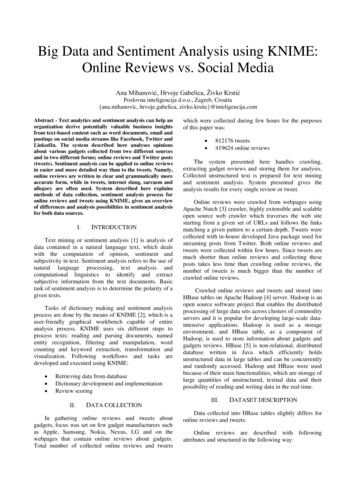
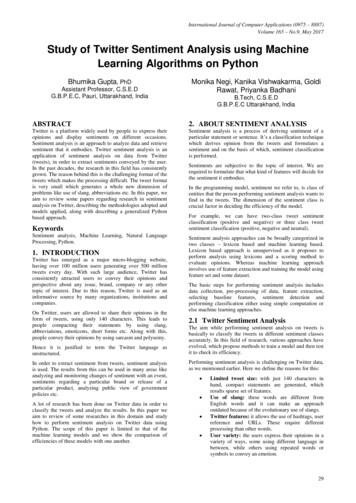


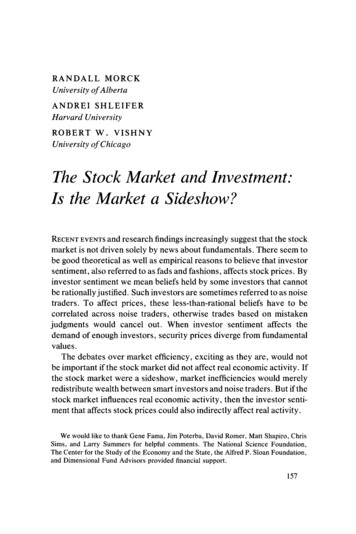
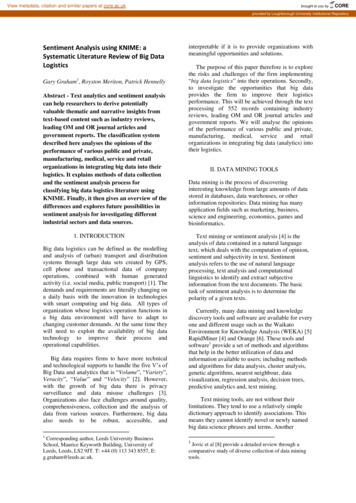
![Index [beckassets.blob.core.windows ]](/img/66/30639857-1119689333-14.jpg)
